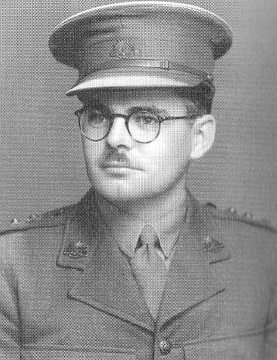SOUTHCOTT, Ronald Vernon
| Service Numbers: | SX26061, S38124 |
|---|---|
| Enlisted: | 29 October 1941 |
| Last Rank: | Captain |
| Last Unit: | 2nd/7th Field Ambulance |
| Born: | Adelaide, South Australia, 15 May 1918 |
| Home Town: | Not yet discovered |
| Schooling: | St Peter's College and University of Adelaide , South Australia |
| Occupation: | Medical Practitioner |
| Died: | South Australia, 9 April 1998, aged 79 years, cause of death not yet discovered |
| Cemetery: | Not yet discovered |
| Memorials: | Hackney St Peter's College WW2 Honour Roll |
World War 2 Service
| 29 Oct 1941: | Involvement Captain, SX26061 | |
|---|---|---|
| 29 Oct 1941: | Involvement Captain, S38124 | |
| 29 Oct 1941: | Enlisted Wayville, SA | |
| 29 Oct 1941: | Enlisted SX26061, 2nd/7th Field Ambulance | |
| 2 Oct 1946: | Discharged | |
| 2 Oct 1946: | Discharged SX26061, 2nd/7th Field Ambulance |
Help us honour Ronald Vernon Southcott's service by contributing information, stories, and images so that they can be preserved for future generations.
Add my storyBiography contributed by Annette Summers
SOUTHCOTT Ronald Vernon DSc MD FRACMA DTM&H
1918- 1998
Ronald Vernon Southcott was born on the 15th May 1918; he was the son of Horace Southcott and Mary (Marie) Robertson, nee Carter. He was educated at St Peter’s College and the University of Adelaide where he graduated MB BS in 1941. While at school, at the age of sixteen, he developed a lifelong interest, in mites (Acari). His mentor, Herbert Womersley, the acarologist at SA Museum, named the trombidiid mite (Microtrombidium Southcotti), which Southcott had collected in the Adelaide Hills, after him in 1934.
Southcott enlisted in the AAMC, at the rank of captain, and served from 1942. He was attached to the 19th Inf Bde and posted to 7th FdAmb in NT, around the Batchelor-Coomalie Creek area, just after the bombing of Darwin, in February 1942. After two months his unit was transferred to the Atherton Tablelands in Northern QLD. He recalled that his training was so arduous that there was no time for entomology while he was there. The unit reformed at Wayville for travel by train back to the Atherton Tablelands before going to PNG. The train was derailed in Proserpine, and while looking for insects on the local golf course, he was left behind. Southcott eventually arrived where the whole 6th Div had been assembled. He spent the next 14 months training in preparation for jungle campaigns. This gave him time to investigate mites and other insects and apply them to the relationship of military hygiene, thus preventing disease in soldiers, which was not always appreciated by his senior officers. Eventually, his unit was sent to join the Aitape-Wewak campaign on the Bontekoe, in 1944. On arrival, Southcott was sent to replace a MO in 2/6th Cavalry Commando Bn, at Babiang on the coast. Southcott recalled that because of his limited experience incoming casualties were evacuated further down the line. Although not pleased with this as it resulted in little medical work, he was able to explore the insect population in the area. During his time along the northern coast of PNG in one month only he received nine hundred casualties ranging from battle wounds, malaria, typhus, dysentery and dengue fever. Southcott was discharged from the army in 1946.
Southcott continued his interests after the war; he obtained his MD (Adelaide) in 1957, and DSc (Adelaide) in 1962. His toxinological contributions included the description and naming of the box jellyfish Chironex fleckeri (named after his South Australian colleague Hugo Flecker) between 1950 and 1957. In addition, he continued his interests in mites, described the taxonomy and description of Australian scorpions, and made the first observations regarding the introduced fiddleback spider. With Sir John Cleland, he was the first to suggest (1969) that the death of Dr Xavier Mertz and the illness of Sir Douglas Mawson in Antarctica was due to hypervitaminosis A. He was a founding member of the International Society on Toxinology and served on the Toxicon Editorial Board for more than 30 years. He was a senior medical administrator with the Commonwealth Repatriation Department from 1949 -1978. He was an honorary consultant in toxinology at the ACH for 30 years. He was the chairman of the Board of the SA Museum from 1974-1982. He was president of the Royal Society of South Australia twice (1955 and 1961) and awarded the gold medal of the Society of (Verco Medal) in 1965. He published 230 books and scientific papers which related to entomology, acarology, toxic fungi, fish and zoonotic diseases. He married Heather Miller, daughter of GR Miller on 5th April 1952. Ronald Vernon Southcott died on 9th April 1998 and was survived by his wife and two daughters.
Source
Blood, Sweat and Fears III: Medical Practitioners South Australia, who Served in World War 2.
Swain, Jelly, Verco, Summers. Open Books Howden, Adelaide 2019.
Uploaded by Annette Summers AO RFD









